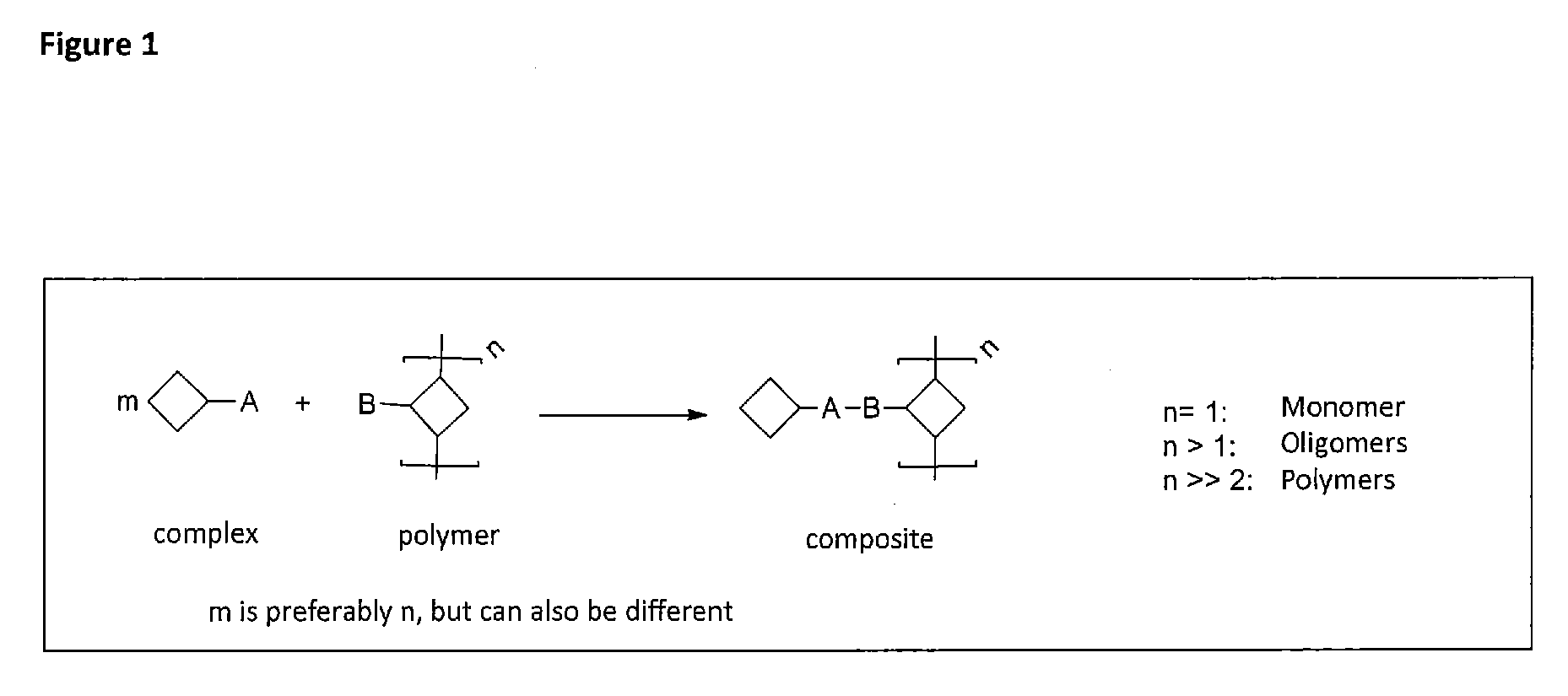Cross-linking and stabilization of organic metal complexes in networks
a multi-dimensional network and organic metal technology, applied in the direction of organic chemistry, group 5/15 element organic compounds, luminescent compositions, etc., can solve the problems of low-cost liquid-processing polymer that allows no simple sequential application of defined, thin layers, and no controlled build-up of well-defined metal complex-functionalized polymers, etc., to achieve greater shifts of energy potentials, increase the efficiency of emitters, and increase the possibility of non-radiative relaxation processes
- Summary
- Abstract
- Description
- Claims
- Application Information
AI Technical Summary
Benefits of technology
Problems solved by technology
Method used
Image
Examples
example 1
[0078]In the described invention such reactions are preferred which do not need the addition of another reactant besides the metal complex and the second reactant, i.e. reactions that need at the most a catalyst that does not interfere with the further use. Examples for such reactions are 1,3-bipolar cycloadditions, Diels-Alder reactions, nitrone-alkyne reactions, nitril oxide-alkyne reactions, thiol-ene reactions, thiol-yne reactions, thiol-isocyanate reactions, tetrazole-alkene reactions and other methods known as click reactions in chemical literature.
[0079]Preferred are reactions which are catalyzed by the metal itself contained in the metal complex, which corresponds to a self-catalyzed cross-linking. One example is the copper-catalyzed click reaction between a terminal or activated alkyne and an azide. This reaction provides regioselectively and in high yields and conversions 1,4-triazoles (see FIG. 2).
example 1.1
Cu Complex Catalyzed Click Reaction Between Terminal Alkynes and Azides
[0080]Phenylacetylene (103 mg, 1.0 mmol, 1.0 eq.) and benzyl azide (133 mg, 1.0 mmol, 1.0 eq.) were dissolved in an air-tight lockable vial with a septum in 10 mL dry dichloromethane. The Cu complex (catalytic or stoichiometric amounts) shown below was added, the vial sealed and the reaction stirred at room temperature for 2 days. For the removal of the catalyst complex the reaction mixture was put in 50 mL methanol and stirred for 20 min. The complex was removed by filtering and the filtrate was concentrated. Removal of the solvent and drying of the product in high vacuum resulted in the compound 1-benzyl-4-phenyl-1H-1,2,3-triazole as light yellow solid with 95% yield (245 mg, 0.95 mmol). The identity of the product was proven by NMR-spectroscopy, infrared spectroscopy and high-resolution mass spectroscopy.
[0081]
example 1.2
Cu Complex Catalyzed Click Reaction Between Cu Alkyne Complex and Azides
[0082]The Cu complex (1.341 g, 1.0 mmol, 1.0 eq.) as first reactant was dissolved in an air-tight lockable vial with a septum in 10 mL dry dichloromethane and benzyl azide (466 mg, 3.5 mmol, 3.5 eq.) as second reactant was added. The reaction was stirred at room temperature for 12 hours, filtered over a syringe filter and precipitated by adding dropwise into diethyl ether. Rinsing of the precipitated solid with diethyl ether and drying of the product in high vacuum resulted in the compound tris-(4-(2-(1-benzyl-1H-1,2,3-triazol-4-yl)ethyl)-2-(diphenylphosphino)pyridin)-di-copper-diiodide as light green solid in 61% yield (1.052 g, 0.61 mmol). The identity of the product was proven by NMR-spectroscopy, infrared spectroscopy mass spectroscopy and elemental analysis.
[0083]Analogously the reaction was also conducted with further azides shown in table 1 as second reactant according to the same procedure.
[0084]
[0085]
TA...
PUM
| Property | Measurement | Unit |
|---|---|---|
| temperatures | aaaaa | aaaaa |
| temperatures | aaaaa | aaaaa |
| thickness | aaaaa | aaaaa |
Abstract
Description
Claims
Application Information
 Login to View More
Login to View More - R&D
- Intellectual Property
- Life Sciences
- Materials
- Tech Scout
- Unparalleled Data Quality
- Higher Quality Content
- 60% Fewer Hallucinations
Browse by: Latest US Patents, China's latest patents, Technical Efficacy Thesaurus, Application Domain, Technology Topic, Popular Technical Reports.
© 2025 PatSnap. All rights reserved.Legal|Privacy policy|Modern Slavery Act Transparency Statement|Sitemap|About US| Contact US: help@patsnap.com



